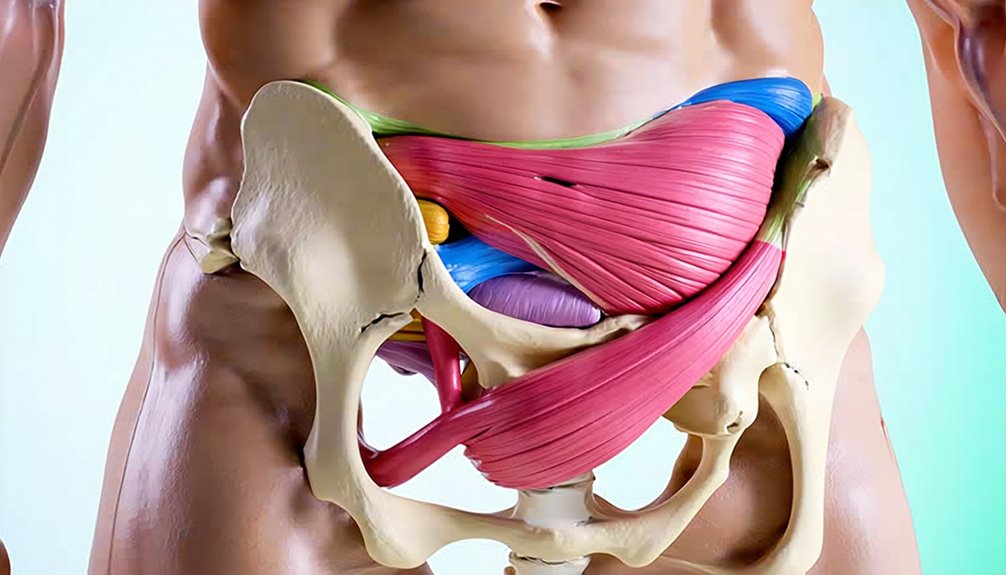Yes, men do have a pelvic floor, which includes important muscles and tissues that support essential functions like urinary control and sexual health. This structure plays a significant role in stabilizing the pelvic area, surrounding the urethra, rectum, and prostate. Maintaining a strong pelvic floor can enhance overall well-being, improve bladder control, and boost sexual satisfaction. Weakness or dysfunction in these muscles can lead to various issues, such as incontinence and erectile dysfunction. Understanding your pelvic floor's anatomy and functions is essential for managing your health effectively. Discovering more about these aspects can be beneficial for your overall wellness.
Understanding the Pelvic Floor

The pelvic floor is a complex structure of muscles and connective tissues that supports the pelvic organs, including the bladder, intestines, and, in men, the prostate. Understanding this essential component of male anatomy is important for maintaining pelvic health. The pelvic floor plays a significant role in urinary and bowel control, as well as sexual function. Weakness or dysfunction in this area can lead to various issues such as incontinence, pain, or erectile dysfunction. It's important to recognize that strengthening the pelvic floor through targeted exercises can enhance overall well-being and improve quality of life. By prioritizing pelvic health, you empower yourself to enjoy greater freedom and functionality in daily activities, contributing to a more fulfilling life.
Anatomy of the Male Pelvic Floor
While many may not realize it, the anatomy of the male pelvic floor includes a network of muscles, ligaments, and connective tissues that form a supportive base for various organs. This pelvic anatomy consists primarily of the levator ani and coccygeus muscles, which play vital roles in maintaining pelvic stability. These muscles encircle the urethra, rectum, and prostate, facilitating essential functions. Additionally, connective tissues provide structural support, while ligaments anchor the pelvis to the surrounding structures. Understanding the muscle function within this area helps you appreciate its importance in overall health. A well-functioning pelvic floor can greatly impact urinary and reproductive health, emphasizing the need for awareness and maintenance of this often-overlooked aspect of male anatomy.
Functions of the Male Pelvic Floor

Understanding the functions of the male pelvic floor is essential for recognizing its role in overall health. The pelvic floor muscles provide pelvic stability, supporting the bladder, prostate, and rectum. This stability is vital for maintaining proper posture and preventing discomfort during daily activities. In addition, a well-functioning pelvic floor contributes to sexual function, influencing erectile capability and orgasmic control. When these muscles are strong and coordinated, they allow for improved blood flow and nerve function, enhancing sexual satisfaction. Moreover, the pelvic floor aids in urinary control, preventing leaks and promoting a healthy urination process. By understanding these functions, you can appreciate the importance of maintaining pelvic health for an overall sense of well-being and freedom in your life.
Common Pelvic Floor Disorders
Pelvic floor disorders can greatly impact men's quality of life, often leading to discomfort and emotional distress. Common issues include pelvic pain, which can arise from muscle tension, injury, or inflammation. This chronic pain can affect daily activities and intimacy, creating a cycle of distress. Another prevalent disorder is urinary incontinence, characterized by the involuntary loss of urine. This condition can result from weakened pelvic muscles, nerve damage, or other underlying health problems. Both pelvic pain and urinary incontinence can diminish self-esteem and social interaction, making it essential to address these disorders. Understanding these issues can empower you to seek appropriate treatment and regain control over your bodily functions and overall well-being.
Symptoms of Pelvic Floor Dysfunction

Several symptoms can indicate pelvic floor dysfunction in men, and recognizing them early is vital for effective management. You might experience urinary incontinence, which can manifest as an involuntary loss of urine when you cough, laugh, or exert yourself. Additionally, you could notice challenges related to sexual dysfunction, such as erectile difficulties or decreased sexual satisfaction. Pelvic pain, particularly in the lower abdomen or groin, may also occur, impacting your daily activities and overall quality of life. Changes in bowel habits, including constipation or straining, can be another sign. It's important to pay attention to these symptoms, as they can greatly affect your well-being and indicate underlying issues that require professional evaluation and intervention.
Diagnosis and Assessment Methods
To accurately diagnose pelvic floor dysfunction in men, a combination of physical exam techniques and imaging assessment methods is essential. You'll likely undergo a thorough physical examination to evaluate muscle strength and function, followed by imaging studies to visualize pelvic structures. These approaches help clinicians determine the underlying issues affecting your pelvic floor health.
Physical Exam Techniques
While evaluating the pelvic floor in men, a variety of physical exam techniques can be employed to diagnose and evaluate potential conditions. You might encounter palpation techniques, which involve the clinician using their hands to assess muscle tone and identify any areas of tenderness or dysfunction. These techniques can provide valuable insights into the pelvic floor's health. Additionally, assessment tools, such as questionnaires or functional tests, may be utilized to gauge symptoms and overall function. It's important to discuss your concerns openly with your healthcare provider, as this can guide the examination process and guarantee a thorough approach to your care. Understanding these techniques not only empowers you but also enhances your involvement in your health journey.
Imaging Assessment Methods
Imaging assessment methods play an essential role in the diagnosis and evaluation of pelvic floor conditions in men, as they provide detailed visual information about the structures and functions involved. Ultrasound imaging is often employed for its ability to visualize soft tissue dynamics in real time, helping to assess pelvic floor muscle function. It's non-invasive and can easily be integrated into clinical practice. On the other hand, MRI applications offer an extensive view of pelvic anatomy, allowing for the detailed assessment of underlying pathologies. These imaging techniques not only enhance diagnostic accuracy but also guide treatment planning, ensuring you receive the most effective care tailored to your specific needs. Understanding these methods can empower you in your health journey.
Treatment Options and Strategies

When addressing pelvic floor issues in men, strengthening exercises can play a vital role in improving function. Additionally, professional therapy options, such as pelvic floor physical therapy, may offer specialized support tailored to individual needs. Exploring these treatment strategies can lead to significant improvements in pelvic health.
Strengthening Exercises for Men
To enhance pelvic floor strength, men can incorporate a variety of targeted exercises into their routine. Kegel exercises are vital; they involve contracting and relaxing pelvic muscles, promoting better control. Integrating resistance training can also build overall muscle strength, supporting pelvic alignment. Focus on core stability through exercises like planks and bridges, which engage deep abdominal muscles. Breath control is important during these exercises; practice inhaling deeply while preparing for a contraction, then exhaling during the release. Additionally, flexibility routines, such as yoga or stretching, can improve muscle elasticity and reduce tension. By combining these methods, you'll effectively strengthen your pelvic floor, contributing to better overall health and freedom of movement.
Professional Therapy Options
While many men benefit from self-directed pelvic floor exercises, professional therapy options can provide personalized guidance and effective treatment strategies. Engaging with a certified pelvic floor therapist can help you better understand your body and tailor interventions to your specific needs.
Consider the following therapy modalities:
- Biofeedback: This technique uses sensors to monitor muscle activity, helping you gain awareness and control over your pelvic floor.
- Manual Therapy: Hands-on techniques can release tension and improve mobility in the pelvic region.
- Education and Lifestyle Coaching: Professional therapists can provide insights on posture, movement patterns, and lifestyle choices that impact pelvic health.
Choosing a therapist with professional certifications guarantees that you receive evidence-based care tailored to your unique situation.
Importance of Pelvic Health Awareness
Understanding the significance of pelvic health awareness is essential, as it directly impacts overall well-being. Many men remain unaware of their pelvic floor's role and the potential issues that can arise from neglect. Awareness campaigns play a fundamental role in educating individuals about pelvic health, helping to dispel myths and promote proactive management. By recognizing the importance of this often-overlooked aspect of health, you empower yourself to address concerns like incontinence and pelvic pain before they escalate. Engaging in discussions about pelvic health also fosters a culture of openness, allowing men to seek help without stigma. Ultimately, prioritizing pelvic health awareness can lead to enhanced quality of life and greater freedom in daily activities.
Frequently Asked Questions
Can Pelvic Floor Exercises Benefit Men's Sexual Health?
Pelvic floor exercises can greatly benefit your sexual health. Strengthening these muscles may improve sexual function and help prevent issues like erectile dysfunction. By engaging in regular exercises, you enhance blood flow and muscle control, promoting better erections and overall sexual performance. Additionally, these exercises can increase your awareness of pelvic muscles, leading to a more satisfying sexual experience. Prioritizing pelvic health is crucial for maintaining sexual vigor and confidence.
Are There Specific Pelvic Floor Exercises for Men?
Imagine a bridge, strong yet flexible, supporting your journey. For men, specific pelvic floor exercises like Kegel exercises can enhance pelvic stability. By contracting and relaxing the pelvic muscles, you're not just strengthening your foundation; you're promoting overall health and energy. Incorporating these exercises into your routine can lead to improved sexual function and greater control. Embrace this practice, and you'll find a newfound sense of freedom and confidence in your body.
How Does Aging Affect the Male Pelvic Floor?
As you age, your pelvic floor may undergo age-related changes, leading to potential pelvic floor dysfunction. These changes can include decreased muscle tone and elasticity, which may affect bladder control and sexual health. It's important to stay proactive by engaging in pelvic floor exercises to maintain strength and function. Regular assessments with a healthcare professional can help you address any concerns and guarantee that you're maintaining ideal pelvic health as you age.
Can Weightlifting Impact the Male Pelvic Floor?
Weightlifting can impact the male pelvic floor, especially if proper techniques aren't followed. Engaging in strength training with excessive weight or poor form may lead to pelvic floor dysfunction or injury, increasing the risk of issues like incontinence. It's essential to balance heavy lifting with pelvic floor exercises to maintain strength without compromising stability. Always consider your body's limits and listen to any warning signs to prevent potential weightlifting risks.
What Lifestyle Changes Support Pelvic Floor Health in Men?
So, you think ignoring your pelvic health is a manly trait? Think again! To support your pelvic floor, focus on balanced dietary habits—fiber's your friend! Don't forget stress management; chronic stress can wreak havoc down there. Engage in regular exercise, maintain a healthy weight, and practice mindfulness techniques. Taking these steps doesn't just promote pelvic health; it's a ticket to overall well-being. Your body will thank you, and yes, even your pelvic floor will smile!




